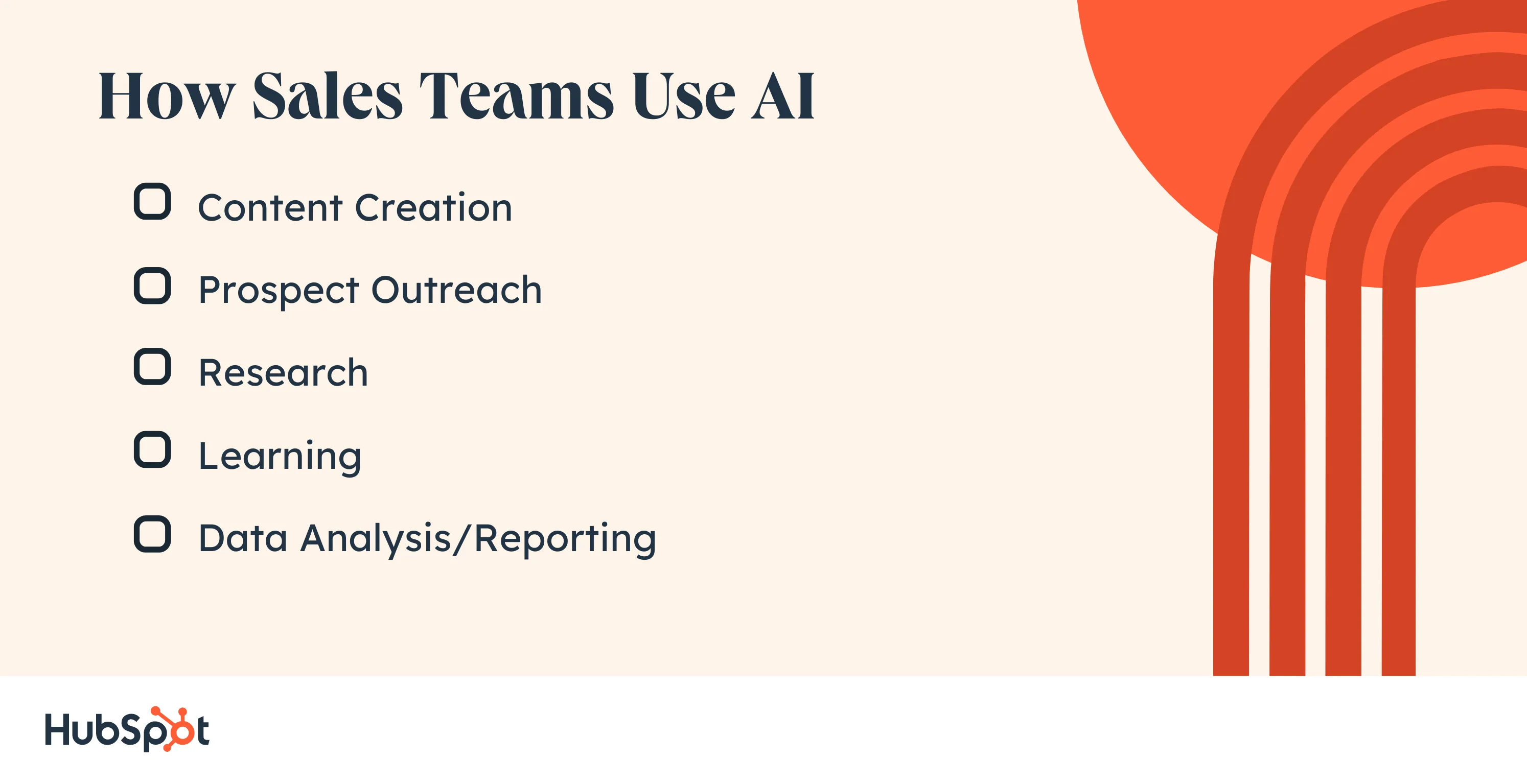Like many disciplines, sales teams everywhere are trying to understand what role artificial intelligence will play in their industry.

AI is no longer a construct of the future. It’s here, and it’s already changing sales as we know it. Today, 68% of business leaders we surveyed believe it will help them scale in a way that would otherwise be impossible.
Whether you’re skeptical, curious, or fully on board, it’s important to educate yourself about how sales reps are using AI. At the very least, you’ll stay up-to-date on trends in sales. On the other hand, you could find a way to boost your productivity and make you a better salesperson.
Table of Contents
How Sales Teams Use AI
To understand AI’s impact on sales, we asked more than 600 sales professionals how they use AI in their work. 74% report using AI in some form in their role, and 60% say they believe AI tools are important to their overall strategy.
A McKinsey report found that companies using AI have experienced the biggest revenue impact in marketing and sales. 29% of marketing and sales teams reported at least a 6% increase in revenue after adopting AI, and 28% reported a decrease in costs.
Here are the top ways these professionals use AI to move the needle in their business.

1. Content Creation
Generative AI tools like HubSpot’s Content Assistant can write copy for sales messages, proposals, or custom landing pages. Generative possibilities go beyond the written word with AI-generated images and even audio.
- 18% of sales professionals use AI for content creation, making it the most popular use case.
- 87% of sales professionals say that AI tools assisting with writing sales content or prospect outreach messages are effective.
What we like: AI prospecting tools can help salespeople move past their own roadblocks with written communication and easily generate personalized messages.
2. Prospect Outreach
AI alleviates one of the most time-consuming tasks in sales: prospecting. New technology lets salespeople find prospects that fit their target audience, research their company and industry, and start a conversation.
Based on inputs or data intelligence about the recipient, you can use AI to personalize messages to the format, tone, and goal you want to accomplish.
According to our recent State of AI Report:
- 16% of sales professionals use AI for prospect outreach.
- 85% of sales professionals say that AI makes their prospecting more effective.
- 72% of sales professionals say it helps them build rapport faster.
- 16% of sales professionals use AI for research.
- 81% of sales professionals say that AI tools offering data-driven insights are effective.
- 15% of all sales professionals use AI to learn how to do things.
- 83% of sales professionals say that AI tools that analyze or simulate sales calls for training/coaching purposes are effective.
- 14% of all sales professionals use AI for data analysis and reporting.
- 81% of sales professionals say that AI tools offering data-driven insights are effective.
What we like: AI helps sales professionals identify, qualify, and reach out to prospects– then organize those contacts in your CRM. Browser add-ons let you bring your AI wherever you have conversations with prospects, whether that’s via email or LinkedIn.
3. Research
AI excels at interpreting large data sets and summarizing information. Examples of research that AI can do for you are performing market and prospect research, finding datasets, and summarizing articles. According to our State of AI Report:
What we like: The more information you have going into a sales conversation, the quicker you can dive into deeper conversations about your lead’s pain points and possible solutions.
4. Learning
Beyond tightening the sales process itself, sales reps are using AI to improve themselves. Some use AI to teach themselves a new skill, such as a new Excel function.
Another important use case is sales coaching and training. Sales teams are using AI-powered tools that can simulate sales conversations for training or can record real sales calls and find insights into areas for improvement.
Our State of AI Report found:
What we like: AI doesn’t replace person-to-person coaching but can enhance it. By flagging leaky funnel points and identifying patterns that lead to higher or lower performance, AI tools can find best practices or gaps where a sales manager can step in to coach.
5. Data Analysis/Reporting
Using machine learning, AI tools excel at analyzing or manipulating large data sets (like a sales pipeline!). Tools enable companies to understand their pipeline and revenue at a deeper level.
What we like: Using AI for data analysis reduces the manual time that you used to spend in spreadsheets and draws from real-time data. Generative capabilities can produce visual reports for you to share with key stakeholders.
Creative Ways for Your Teams to Use AI
Curious about ways your sales team can test AI in the workplace? Take inspiration from these sales teams using AI in their operations.
.webp)
Transcribing Sales Calls. Automating Admin Work. Sales Forecasting. Gathering Lead Intelligence. Sales Coaching.
Writing Cold Emails
Writing sales emails is slow. Adapting templates is a little faster, but still requires time and context. Generative AI enables salespeople to reduce prospecting time by writing personalized messages suited to the company and context.
AI tools can compose messages tailored to the recipient’s company, industry, and other market research. They can adapt it to the format and the requested tone and even rewrite messages for different formats and audiences.
In the Real World
Certified HubSpot Partner Belkins uses AI tools, including ChatGPT and HubSpot’s ChatSpot to draft and structure sales emails.
“AI's incredible generative potential does an amazing job of drafting personalized emails based on simple data about the recipients and the purpose of the email,” said Co-founder Michael Maximoff. “Of course, all sales emails eventually go through rigorous checks by true sales professionals who give a go-ahead for each email, but AI helps save a lot of time and resources in drafting these.”
In the Real World
HubSpot customer Revnew, Inc. integrated ChatSpot into their prospecting workflow and generated 40% more qualified leads and 25% more appointments as a result.
“ChatSpot helps our SDRs and research team find and connect with our ideal prospects. It can search and filter leads based on our criteria,” shared Marketing Manager Jyoti Sahoo. “It also helps us craft personalized messages and automate our outreach. It has increased our response rate, built rapport, and grown our pipeline.”
Following Up With Leads
Once you have a qualified lead, the real work begins. AI can remind you when to follow up with a lead and recommend which leads are most likely to convert so you can know where to spend your time.
These tools can use natural language processing algorithms to detect a customer’s sentiment based on keywords in messages. With this data, they can recommend action steps or personalized emails to address the objections mentioned.
In the Real World
Maria Harutyunyan, co-founder and head of SEO, Loopex Digital, shared how they’ve helped their clients integrate AI.
“One of my client‘s experienced great success when they started using HubSpot’s Sales Hub Pro alongside other marketing initiatives. After just two weeks of implementation, their conversion rate jumped from 15% to 25%. This was due in part to utilizing AI technology within their sales process and optimizing their customer approach via personalized follow-ups tailored to each prospect’s needs as well as automated outreach campaigns that provided timely answers across various touch points– all without needing additional manpower!”
Transcribing Sales Calls
Getting the information you need from a salesperson’s head into a CRM’s notes is a known pain point for everyone involved. It takes the salesperson time they want to spend selling, and missing notes or data can cause problems with the handoff to onboarding.
In the Real World
Sahoo of Revnew, Inc. shared how his sales team uses AI to record call notes.
“We use Otter.ai to help us record and transcribe our calls and meetings. It also generates summaries and action items for us to follow up on. This way, we, mainly our AEs, save a lot of their time, improve communication, and stay organized. It has reduced our follow-up time by 50%.”
What we like: AI-powered transcription works better than human memory and can pull out insights and action points for next steps.
Automating Admin Work
Sales teams waste a lot of time on non-revenue-generating activities — about 40% of their time, according to Dooly. According to HubSpot’s survey, 35% of sales professionals are using AI to eliminate admin work, making it the most popular use case for AI in sales.
Reducing your admin load could take the form of data entry, scheduling, or creating sales scripts. This frees your sales team for more time selling to help you reach them– and you– reach your targets.
Our State of AI survey found that sales professionals save over two hours a day by using AI. Sales reps also say that automating manual tasks helps them reach their sales goals.
In the Real World
Byron Sierra-Matos is one of Apollo.io’s best-performing account executives. At his busiest, he led more than 14 demos a day with prospects, leaving little time to add notes to his CRM.
Collecting information like CRM preferences, contract details, and account notes was difficult to gather and input into Salesforce while on a call.
With Dooly adding notes to the CRM and generating custom sales templates to remind him to gather that data, he created an automated workflow for data entry and saved about an hour a day.
Sales Forecasting
34% of sales professionals report using AI tools to gain data-driven insights such as sales forecasting, lead scoring, and pipeline analysis.
Analyzing large, unstructured data sets with machine learning is what AI does best. AI tools can identify trends and patterns and make predictions about future outcomes, like sales forecasting.
In the Real World
With multiple product divisions and sales teams working independently, Flock Security relied on a manual process to forecast data. They exported data from Salesforce and manipulated spreadsheets each week to create the forecast they needed for stakeholders.
By using Clari, the Flock Security team eliminated manual entry and created a better sales forecast, updated in real-time, with deeper pipeline insights.
Gathering Lead Intelligence
Beyond the obvious cases like outbound messaging, AI has the potential to solve even bigger go-to-market challenges. Challenges like understanding your target audience, their current suppliers or vendors, and their industry.
New AI technology can identify potential leads from market data and give you insights to help you focus your attention and better prepare for sales calls. HubSpot’s ChatSpot.ai, for example, can research company information like funding rounds or tech used on their website.
Other tools can score leads or find social intelligence about your contacts.
In the Real World
Adam Svhoenfeld, co-founder of Keyplay.io and PeerSignal.org, explains how Keyplay.io gathers lead intelligence based on signals like hiring, online presence, and tech stacks.
“While AI can give you B outputs (a nice starting place, but can‘t compete with the polish of a great writer), we see a larger opportunity in using AI to improve raw inputs. For instance, we’re using it to better categorize and segment companies by more than just industry, which is beneficial for the account mapping and list-building side of sales.”
Sales Coaching
With AI, sales teams can record real or simulated sales calls, save the recording with a transcription, and glean insights like key moments and message testing. Instant feedback lets sales managers identify problems quickly and share feedback in context.
In the Real World
Sports technology platform Playbook was growing quickly and struggling to onboard and train new sales reps at scale. Playbook started using Wingman by Clari to record calls and provide instant feedback for both the sales rep and leadership.
Playbook cut its training time in half and improved sales performance through contextualized feedback.
Tips for Implementing AI
Like any new tool, piloting AI can be overwhelming. Follow these five tips for a systematic approach and smooth entry to working with AI.

1. Set a goal.
Before you sign up for a free trial, first slow down and ask yourself what goals you want to accomplish with AI. Is your goal to shorten the sales cycle? Increase your win rates? Focus your attention on one goal first before adding more.
2. Choose the right tool.
Research different tools on the market to see which is the best fit for your needs. Complete demos, read user reviews, and identify which existing software you need the AI tool to integrate with, like Gmail or Salesforce.
3. Test, test, and test again.
Once you’ve narrowed your software to one or two top contenders, assign a small team to enter a trial period and test the different features. Try out generative tools with various inputs and triple-check every communication for accuracy. Request frequent feedback from your test users to see what works or doesn’t work well.
4. Onboard well.
Choosing a tool is Step 1. Step 2 is convincing your team to actually use it. During onboarding, assist them with training, check in about the tools during your 1:1s, and encourage adoption with incentives. You can also ask sales reps who have seen success to share examples and best practices with the rest of the team.
5. Measure success.
Going back to your goal-setting, determine how you’ll measure success for your goals. Monitor KPIs and report back each month to see how AI has impacted your performance.
Grow Your Sales With AI
As we’ve covered, AI is impacting every aspect of the sales process, from training to operations to prospecting. But it isn’t just important because it’s trendy — AI impacts the bottom line.
To keep from being left behind in this new era of the sales industry, give it a chance. Adapting to new technology is never easy, but it can be transformative.
![Download Now: The State of AI in Sales [2023 Report]](https://no-cache.hubspot.com/cta/default/53/6f674af4-3116-43b0-8a54-4a64f926afb6.png)




![Will AI Steal Your Sales Job? We Asked HubSpot Experts [+ Research]](https://blog.hubspot.com/hubfs/AI%20steal%20jobs%20FI.png)

![The Benefits of AI Cold Calling [+Tips and Best Practices]](https://blog.hubspot.com/hubfs/ai-cold-calling.webp)
![How to Understand Your Prospects Better With AI [Expert Insights]](https://blog.hubspot.com/hubfs/AI%20Understanding%20Prospects.png)


